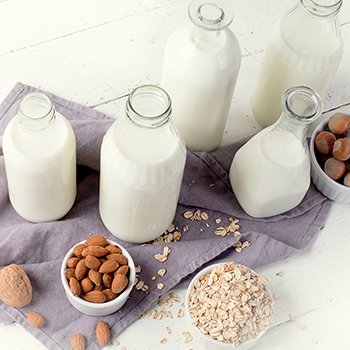ภาพรวมของอุตสาหกรรมนมและนมทางเลือก Overview of the Dairy and Diary Alternatives Industry
953 Views |

By: ดร. เอื้องพลอย ใจลังกา
Auengploy Chailangka, Ph.D.
Director of Chiang Mai Livestock Products Research and Development Center
Livestock Products Division
Department of Livestock Development, Thailand
auengploy@gmail.com
สถานการณ์ปัจจุบันและแนวโน้มของผลิตภัณฑ์นมและนมทางเลือก
ในปี พ.ศ. 2565 ตลาดผลิตภัณฑ์นมและนมทางเลือกทั่วโลกมีมูลค่าประมาณ 568 พันล้านเหรียญดอลลาร์สหรัฐ และมีแนวโน้มเพิ่มขึ้นร้อยละ 8 ซึ่งสวนทางกับปริมาณการผลิตผลิตภัณฑ์นมในปัจจุบันที่ลดลงร้อยละ 0.6 โดยการเปลี่ยนแปลงนี้มีสาเหตุหลักมาจากราคาของวัตถุดิบและผลิตภัณฑ์นมที่เพิ่มสูงขึ้น หากพิจารณาจากสถานการณ์นมในกลุ่มประเทศเอเชียแปซิฟิก พบว่าประเทศอินเดียเป็นผู้นำในการบริโภคนมและผลิตภัณฑ์จากนม ซึ่งแซงหน้าประเทศจีนและญี่ปุ่น โดยในปี พ.ศ. 2565 ที่ผ่านมา คนอินเดียบริโภคนมสูงถึง 133 ล้านตัน และคาดว่าจะมีแนวโน้มในการบริโภคเพิ่มสูงขึ้นเป็นร้อยละ 33 ภายในปี พ.ศ. 2576 ในขณะที่ประเทศจีนมีอัตราการบริโภคนมในปี พ.ศ. 2565 อยู่ที่ 39 ล้านตัน และมีแนวโน้มเพิ่มขึ้นเป็น 41 ล้านตัน หรือคิดเป็นร้อยละ 5 ภายในปี พ.ศ. 2576 โดยผลิตภัณฑ์นมที่มีอัตราการเติบโตรวดเร็วที่สุดในช่วงปี พ.ศ.
2565-2566 ของแต่ละประเทศจะมีความแตกต่างกัน ซึ่งผลิตภัณฑ์เนยแข็ง (Cheese) ในประเทศอินเดียมีอัตราการเติบโตเพิ่มขึ้น ร้อยละ 11 เช่นเดียวกับในประเทศเกาหลีที่มีอัตราการเติบโตเพิ่มขึ้น ร้อยละ 13 ในขณะที่แถบประเทศเพื่อนบ้านของไทยอย่างเวียดนาม พบว่า ผลิตภัณฑ์นมพร้อมดื่มมีอัตราการเติบโตร้อยละ 10 ซึ่งมากกว่าผลิตภัณฑ์ประเภทอื่นๆ สำหรับประเทศมาเลเซียนั้น ผลิตภัณฑ์นมระเหย (Evaporated milk) ได้รับความนิยม และมีอัตราการเติบโตถึงร้อยละ 32 ส่วนในประเทศฟิลิปปินส์ พบว่า ผลิตภัณฑ์โยเกิร์ตมีการเติบโตมากที่สุดอยู่ที่ร้อยละ 38 ส่วนในประเทศไทย พบว่าผลิตภัณฑ์โยเกิร์ต โดยเฉพาะแบบถ้วย (Cup yogurt) มีอัตราการเติบโตสูงกว่าผลิตนมชนิดอื่นอยู่ที่ร้อยละ 16
ตัวอย่างผลิตภัณฑ์นมและนมทางเลือกจากพืชที่น่าสนใจ
1. ผลิตภัณฑ์นมเพื่อสุขภาพและความต้องการเฉพาะ
บริษัท Fonterra ผู้ส่งออกนมรายใหญ่ที่สุดในโลกจากประเทศนิวซีแลนด์ได้พัฒนาผลิตภัณฑ์เสริมอาหารแบรนด์ Nutiani ซึ่งเน้นความเป็นอยู่ที่ดีของผู้บริโภค (Wellbeing nutrition brand) และบริษัท Yili จากประเทศจีน ได้ออกผลิตภัณฑ์ SATINE ซึ่งเป็นนมที่มีแอคทีฟแลคโตเฟอร์ริน (Milk with active lactoferrin) ซึ่งได้รับการวิจัยว่าเป็นผลิตภัณฑ์นมออร์แกนิกที่มีส่วนช่วยในการส่งเสริมระบบภูมิคุ้มกันของร่างกายมนุษย์
2. โยเกิร์ตและกรีกโยเกิร์ตที่อุดมไปด้วยพรีไบโอติกส์และโพรไบโอติกส์
หลายงานวิจัย พบว่า โยเกิร์ตและกรีกโยเกิร์ตที่อุดมไปด้วยพรีไบโอติกส์และโพรไบโอติกส์นั้นมีความสามารถในการช่วยลดปริมาณไขมันอิ่มตัวและคอเลสเตอรอลในผลิตภัณฑ์นมได้ นอกจากนี้ ยังช่วยปรับปรุงระบบย่อยอาหาร เสริมสร้างการทำงานของระบบภูมิคุ้มกัน และส่งเสริมการเจริญเติบโตของจุลินทรีย์ชนิดที่ดีในลำไส้
3. ผลิตภัณฑ์นมทางเลือกที่สร้างสรรค์หลากหลายรูปแบบ
ผลิตภัณฑ์นมทางเลือกได้รับการพัฒนาให้มีความหลากหลายมากขึ้น เช่น โยเกิร์ตจากนมอัลมอนด์
นมข้าวโอ๊ต กะทิคีเฟอร์ (Kefir) และกะทิหมักที่เต็มไปด้วยจุลินทรีย์โพรไบโอติกส์ เพื่อส่งเสริมสุขภาพของลำไส้และระบบย่อยอาหาร หรือผลิตภัณฑ์ชีสจากพืชหลายรูปแบบที่พัฒนาออกมาเพื่อเป็นทางเลือกให้กับผู้บริโภคมากยิ่งขึ้น
4. นมจากกระบวนการเพาะเลี้ยงเซลล์
นมจากกระบวนการเพาะเลี้ยงเซลล์หรือผลิตภัณฑ์นมหมัก เป็นการสร้างโปรตีนนมผ่านกระบวนการหมัก โดยอาศัยจุลินทรีย์ แบคทีเรีย หรือยีสต์ เพื่อสังเคราะห์โปรตีน ซึ่งรูปแบบสามมิติของดีเอ็นเอ (3-D printed DNA) จากวัวจะใช้สำหรับเข้ารหัสคำสั่งในการสังเคราะห์โปรตีนเคซีนและเวย์โปรตีน โดยจะถูกต่อเข้ากับพลาสมิด (plasmid) ดีเอ็นเอของเซลล์จุลินทรีย์ ซึ่งยีสต์หรือจุลินทรีย์ชนิดนั้นๆ จะผลิตโปรตีนนมผ่านกระบวนการหมัก จากนั้นโปรตีนนมจะถูกแยกออกมา และรวมเข้ากับส่วนผสมอื่นๆ ได้แก่ ไขมันจากพืช แร่ธาตุ น้ำตาล และน้ำสะอาด เพื่อให้ได้น้ำนมออกมา
Current situation and trends in dairy products and dairy alternatives
In 2022, the global dairy and dairy alternatives market is estimated to be worth USD 568 billion. It is expected to grow by 8%, in contrast to the current dairy production volume decreasing by 0.6%. The primary cause of this shift is the rising prices of raw materials and dairy products. Considering the situation in Asia Pacific countries, India has the highest consumption of milk and dairy products, with consumption higher than China and Japan. In 2022, milk consumption in India is 133 million tons and is expected to increase by 33% by 2033. Meanwhile, China's consumption in 2022 is 39 million tons and is likely to increase to 41 million tons or by 5% by 2033. The dairy products with the fastest growth rate in each country during 2022-2023 differ. Similar to Korea, where the growth rate is 13%, cheese products grow by 11% in India. Meanwhile, in Thailand's neighboring country, Vietnam, ready-to-drink milk products have a growth rate of 1%, which is higher than other types of products. Evaporated milk products are top-rated in Malaysia, where their growth rate is 3%. Yogurt products have the highest growth in the Philippines at 38%. In Thailand, yogurt products, especially cup yogurt, have a higher growth rate of 16% compared to other dairy products.
Interesting examples of dairy products and dairy alternatives
1. Healthy dairy products for specific needs
Fonterra, the world's largest dairy exporter from New Zealand, has developed Nutiani, a wellness nutrition brand, while Yili, a Chinese company, introduced SATINE, organic milk containing active lactoferrin with immune system-boosting properties.
2. Yogurt and Greek yogurt rich in prebiotics and probiotics
Many studies have found that yogurt and Greek yogurt, which are rich in prebiotics and probiotics, can lower saturated fat and cholesterol. It also improves digestion, strengthens immune function and promotes gut microbiota growth.
3. Creative dairy alternatives
Many dairy alternative products, such as yogurt made from almond milk, oat milk, coconut milk kefir, and fermented coconut milk containing probiotics, have been developed to enhance the health of the intestines and digestive system. Furthermore, a wide variety of plant-based cheese alternatives have been developed and manufactured to give customers other choices.
4. Cellular agriculture of milk
Cellular agriculture is a production technique of milk through the fermentation process with the help of microorganisms, bacteria, or yeast. In this process, casein and whey proteins are encoded by
3-D printed bovine DNA. The obtained casein and whey protein are then spliced into the plasmid DNA of microbial cells, producing milk protein through fermentation. The milk proteins are then separated and combined with other ingredients, including vegetable fats, minerals, sugar, and water, to produce milk.






